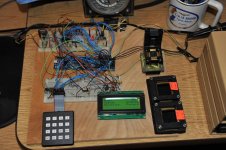I've got a project coming up that I'm looking at using a VFD with closed loop vector control capabilities. I was looking at the Hitachi WJ200 drive, parts of the manual seem like its capable of it, but other parts seem like it needs an expansion card which is a future item.
Anyone have any experience with doing this on the Hitachi drive?
This is my first foray into closed loop vector. It is a really simple project, motor to a screw jack, speed controlled manually via a pot. Forward/reverse push button control with manual knob speed adjust, just dead simple. I would like the power ability at 0 speed given by the closed loop control. I think I could accomplish what I need to with sensorless vector, but would like the 0 speed ability.
I'm looking in the 2-5hp range with a DynaparHS35 encoder on the motor. This is a operate at 75Hz for 4 minutes, then slow down to .5Hz range for a few minutes. It will be a very minimal use item, but the slow speed is crucial to adjustments of the jack.
I've done about a half dozen different VFD's, but never a closed loop vector unit and haven't found a lot out there sub 1.5k$ units that advertise that they are capable.
If you have a suggestion as to a different drive to use that'd also be appreciated if the WJ200 isn't the right one for the job.
Thanks,
Ryan
Anyone have any experience with doing this on the Hitachi drive?
This is my first foray into closed loop vector. It is a really simple project, motor to a screw jack, speed controlled manually via a pot. Forward/reverse push button control with manual knob speed adjust, just dead simple. I would like the power ability at 0 speed given by the closed loop control. I think I could accomplish what I need to with sensorless vector, but would like the 0 speed ability.
I'm looking in the 2-5hp range with a DynaparHS35 encoder on the motor. This is a operate at 75Hz for 4 minutes, then slow down to .5Hz range for a few minutes. It will be a very minimal use item, but the slow speed is crucial to adjustments of the jack.
I've done about a half dozen different VFD's, but never a closed loop vector unit and haven't found a lot out there sub 1.5k$ units that advertise that they are capable.
If you have a suggestion as to a different drive to use that'd also be appreciated if the WJ200 isn't the right one for the job.
Thanks,
Ryan


 having first investigated it around 1997 when developing FOC algorithms for a Motorola 56xxx series DSP.
having first investigated it around 1997 when developing FOC algorithms for a Motorola 56xxx series DSP.

